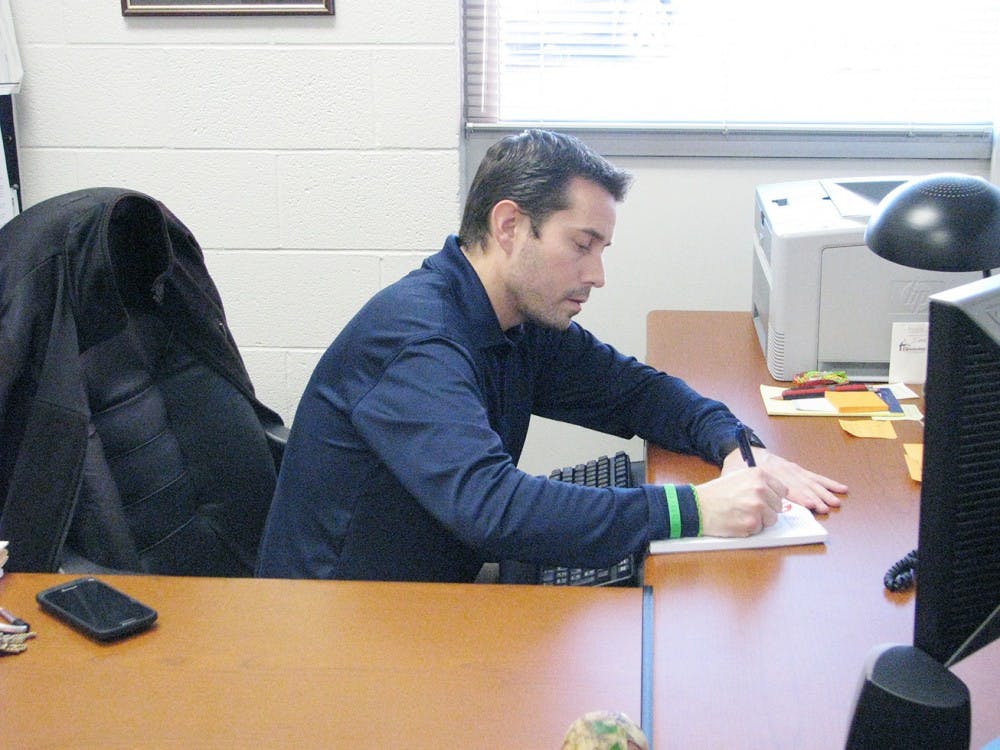Shippensburg University is made up of 20 intercollegiate athletic teams that continue to provide a wealth of success stories. Often with success, comes increased attention on the student-athletes with statistical accomplishments, memorable plays or outstanding leadership. However, little thought is given to the hard work and dedication of the athletic trainers who play an integral part in the success of SU athletics.
One of the athletic trainers responsible for the health and safety of the Raiders, is SU’s director of Sports Medicine, Wesley Mallicone.
According to the National Athletic Trainers Association, “The services provided by [athletic trainers] comprise prevention, emergency care, clinical diagnosis, therapeutic intervention and rehabilitation of injuries and medical conditions”.
Mallicone’s interest in becoming an athletic trainer stemmed from his involvement in sports throughout his youth. This led to an interest in a profession revolving around sports.
“Knowing other athletic trainers and professionals in the health care field, I wanted to be involved in sports and being an athletic trainer was the way to do so,” Mallicone said.
In 1999, Mallicone graduated from Duquesne University with a Bachelor’s of Science degree in Athletic Training. Following graduation Mallicone came to SU as a graduate assistant in sports medicine under the guidance of Steven J. Heckler. At that time, Heckler was the first and only director of sports medicine at SU and one of Mallicone’s biggest mentors.
After graduating from SU with a master’s degree in psychology in December 2000, Mallicone had several opportunities to work internships with the Pittsburgh Pirates during a home stand (six games), a full season with the Philadelphia Eagles and the Barcelona Dragons (a member of NFL Europe) for two and a half months.
“While I was in Barcelona, I was looking for other job opportunities within my profession,” Mallicone said. “Coincidentally, Steve [Heckler] was retiring after 27 years at SU and I applied for the vacancy. When all was said and done, I found myself as the director of sports medicine at the age of 25.”
When Mallicone stepped into the role of the director of sports medicine in 2002, he had a staff of three graduate assistants, one internship position and several undergraduate work-study student personnel. As the years went by, the sports medicine staff grew from one to two full-time athletic trainers, then to three and currently four full-time athletic trainers and an internship position.
As for a typical day for Mallicone, there is no typical day. Mallicone arrives on campus at varied times depending on the responsibilities for that day. “I get here as early as 5:15 a.m. some mornings and stay until as late as midnight,” Mallicone said. “It’s virtually a 24/7 job. However, we continually strive to address the quality of life issues in our work environment”.
Talk about multi-tasking, Mallicone’s typical day consists of all of the following: coordinates sports medicine services for the 20 intercollegiate athletic teams; manages four on-campus sports medicine facilities; supervises the sports medicine staff; serves as the liaison for the NCAA mandatory drug testing program; communicates with Etter Health Center regarding student-athlete appointments and illnesses; administers the secondary health insurance program; schedules physician referrals, X-Rays and MRIs; communicates with parents/guardians when necessary; provides daily injury reports to coaches; evaluates and treats student-athlete injuries; travels with various teams; and of course, follows up on emails and phone messages and still finds time to sneak over to Starbucks for a caramel latte.
Among the daily duties of an athletic trainer, one challenge that arises is motivating injured players to make a full recovery and return to the team in a timely manner. In professional sports and even Division I, injured student-athletes are motivated by the potential of signing contracts, the fame and attention they receive and even their athletic legacy. However, student-athletes at the Division II or III levels often do not experience those benefits and rather play simply for the love of the game. So how does an athletic trainer motivate a senior coming off of surgery that is set to graduate and start a career?
For Mallicone, he can challenge some student-athletes with verbal and visual cues by demonstrating that he can do things that they no longer can, such as hopping on one foot. In addition to identifying the various ways in which each student-athlete will respond positively, Mallicone attempts to be creative and change the exercises frequently to keep the student-athlete from becoming bored by the monotonous exercises.
However, according to Mallicone, physical injuries are not the only obstacles facing athletic trainers.
“On a daily basis, any student-athlete may be dealing with physical, emotional, personal or academic struggles,” Mallicone said. “As a certified athletic trainer it’s my job to assist in being aware of these potential issues and providing the student-athletes with the proper guidance to assist them in their particular problem. It’s in these cases that I find my master’s degree in psychology to be most helpful. You get to know your student-athletes and what makes them tick,” Mallicone said. Everyone is different, so you have to find a way. Also, Mallicone said, “In the athletic training profession, athletic trainers are governed by their state regulations and are always cognizant of performing their duties within their scope of practice.”
While shifting back and forth from one student-athlete to another in the athletic training room, cracking a few jokes in between, Mallicone instructed each patient to perform various rehabilitation exercises or methods of treatment. All the while, his never-ending smile illuminated the room, as the chaotic atmosphere of the athletic training room seemed routine and natural as if Mallicone were fielding a lazy fly ball. As time elapsed and student-athletes flowed in and out of the facility, it grew more and more apparent that this was not just a job, but rather his passion.




The Slate welcomes thoughtful discussion on all of our stories, but please keep comments civil and on-topic. Read our full guidelines here.